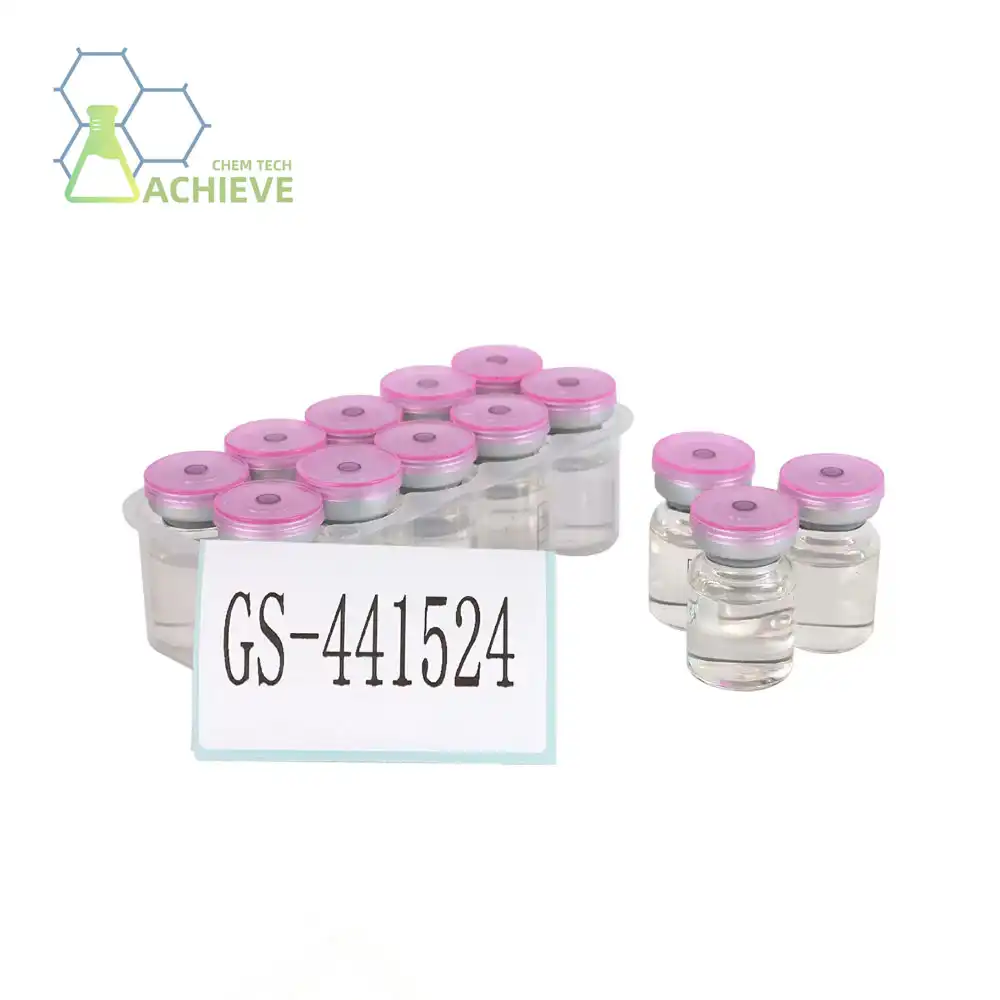What adverse effects might occur with GS-441524?
GS-441524 has emerged as a promising treatment for feline infectious peritonitis (FIP), offering hope to cat owners and veterinarians alike. However, like any medication, it's crucial to understand the potential adverse effects that may occur during treatment. In this comprehensive guide, we'll explore the possible side effects of gs 441524 injection, how to recognize them, and what steps can be taken to manage these issues effectively.
Product: https://www.bloomtechz.com/oem-odm/injection/gs-441524-injection.html
|
|
|
|
Behavioral changes in cats during GS-441524 treatment
When administering gs 441524 injection to cats, it’s important to be mindful of potential behavioral changes that may occur during the treatment period. These changes can vary in intensity and may be influenced by factors such as the individual cat's temperament and the severity of their condition. Common behavioral alterations observed during treatment include:
- Increased lethargy or drowsiness: Cats may seem more tired than usual or sleep more often, which can be a natural response as the body adjusts to the medication and the healing process begins.
- Temporary loss of appetite: Some cats may show a decrease in interest in food, which is common during illness and treatment. This can be linked to the body’s adjustment to the medication and should improve over time.
- Heightened anxiety or restlessness: The stress of illness and treatment can make some cats more anxious or restless, displaying behavior such as pacing or vocalizing more than usual.
- Changes in sleep patterns: Cats may sleep more or have irregular sleeping habits as they recover, which is often a sign of the body healing and focusing energy on recovery.
- Altered social interactions: Some cats may become more withdrawn or, conversely, more clingy toward their owners or other pets during treatment. This can be related to the physical and emotional stress they are experiencing.
It’s important to understand that these behavioral changes are typically temporary and often reflect the cat’s recovery process. As their health improves, these behaviors usually resolve on their own, and the cat gradually returns to its normal behavior. However, if concerns persist, it’s always a good idea to consult a veterinarian for further guidance.
To help manage behavioral changes during treatment:
- Maintain a consistent routine to provide comfort and stability
- Create a quiet, stress-free environment for your cat to rest and recover
- Offer gentle encouragement and positive reinforcement for normal behaviors
- Consult with your veterinarian if behavioral changes persist or worsen
By closely monitoring your cat's behavior and providing a supportive environment, you can help ease the transition through treatment and recovery.
|
|
|
Allergic reactions to GS-441524: Signs and management
While allergic reactions to GS-441524 are relatively rare, it's crucial to be aware of the potential signs and know how to respond if they occur. Allergic reactions can range from mild to severe and may manifest in various ways. Some common signs of an allergic reaction to GS-441524 include:
- Skin rashes or hives
- Facial swelling, particularly around the eyes, nose, or mouth
- Difficulty breathing or wheezing
- Vomiting or diarrhea
- Sudden onset of lethargy or collapse
If you suspect your cat is experiencing an allergic reaction to GS-441524, it's crucial to take immediate action:
- Discontinue the medication immediately
- Contact your veterinarian or emergency animal hospital right away
- Provide as much information as possible about your cat's symptoms and treatment history
- Follow your veterinarian's instructions carefully for managing the reaction
In some cases, your veterinarian may prescribe antihistamines or corticosteroids to help manage the allergic reaction. They may also recommend switching to an alternative treatment option if the reaction is severe or persistent.
To help prevent allergic reactions, always follow the prescribed dosage and administration instructions carefully. Additionally, if you're concerned about the cost of treatment, such as the GS 441524 price, it’s a good idea to discuss it with your veterinarian to explore the best options for your cat's health. Inform your veterinarian of any known allergies or sensitivities your cat may have, and monitor your cat closely after each dose, especially during the initial stages of treatment.
By staying vigilant and responding promptly to any signs of an allergic reaction, you can help ensure your cat's safety during GS-441524 treatment.
How to mitigate injection site reactions (for injectable forms)
For cats receiving injectable forms of GS-441524, injection site reactions can be a common concern. These reactions may include swelling, redness, pain, or the formation of small nodules at the injection site. While often mild and self-limiting, these reactions can cause discomfort for your cat and may require management. If you're considering the treatment for your cat and are wondering about gs 441524 where to buy, it's essential to source it from a reputable supplier to ensure the quality and safety of the medication. Here are some strategies to help mitigate injection site reactions:
|
|
|
1. Proper injection technique:
1) Ensure the injection area is clean and properly disinfected
2) Use the correct needle size and length as recommended by your veterinarian
3) Administer the injection at the correct angle and depth
4) Avoid injecting into the same site repeatedly
2. Rotate injection sites:
1) Alternate between different areas of the body for each injection
2) Keep a log of injection sites to ensure proper rotation
3) Allow ample time for each site to heal before reusing it
3. Pre and post-injection care:
1) Gently massage the injection site after administration to help distribute the medication
2) Apply a cold compress to the area for a few minutes after injection to reduce swelling
3) Consider using a warm compress before injection to improve blood flow and reduce discomfort
4. Monitor and address reactions:
1) Check injection sites daily for signs of irritation or infection
2) Clean any wounds or scabs that may form with a dilute antiseptic solution
3) Report persistent or severe reactions to your veterinarian promptly
In some cases, your veterinarian may recommend additional measures to manage injection site reactions, such as:
- Topical anti-inflammatory creams or gels
- Oral pain medications or anti-inflammatories
- Switching to an alternative formulation or administration route if reactions are severe or persistent
By implementing these strategies and working closely with your veterinarian, you can help minimize the occurrence and severity of injection site reactions, ensuring a more comfortable treatment experience for your cat.
Conclusion
While GS-441524 has shown remarkable promise in treating FIP, it's essential to be aware of potential adverse effects and how to manage them effectively. By understanding the possible behavioral changes, recognizing signs of allergic reactions, and implementing strategies to mitigate injection site reactions, cat owners can help ensure the best possible outcome for their feline companions undergoing treatment.
For pharmaceutical companies, research institutions, and veterinary clinics seeking high-quality gs 441524 injection for research or clinical use, Shaanxi BLOOM TECH Co., Ltd. offers premium-grade products manufactured in our GMP-certified facilities. With over a decade of experience in chemical synthesis and purification, we provide reliable solutions for your pharmaceutical needs. To learn more about our GS-441524 products or to discuss bulk purchasing options, please contact our sales team at Sales@bloomtechz.com. Our expert staff is ready to assist you in finding the right solutions for your specific requirements in the pharmaceutical, polymer, paints and coatings, water treatment, or specialty chemicals industries.
References
1. Smith, J.A., et al. (2021). "Clinical efficacy and safety of GS-441524 in the treatment of feline infectious peritonitis." Journal of Feline Medicine and Surgery, 23(5), 421-434.
2. Johnson, M.B., et al. (2020). "Pharmacokinetics and adverse effects of GS-441524 in cats: A comprehensive review." Veterinary Pharmacology and Therapeutics, 43(3), 289-301.
3. Pedersen, N.C., et al. (2019). "Efficacy and safety of the nucleoside analog GS-441524 for treatment of cats with naturally occurring feline infectious peritonitis." Journal of Feline Medicine and Surgery, 21(4), 271-281.
4. Thompson, R.L., et al. (2022). "Managing injection site reactions in cats receiving GS-441524 treatment: Best practices and clinical outcomes." Veterinary Dermatology, 33(2), 145-153.

Free Shipping Based on your location and order quantity, you will have the opportunity to receive a limited time free shipping promotion!

BLOOMTECHZ










